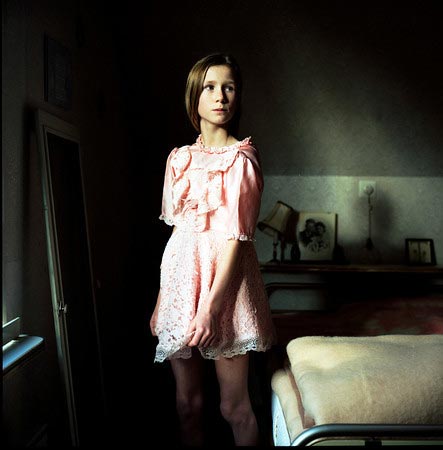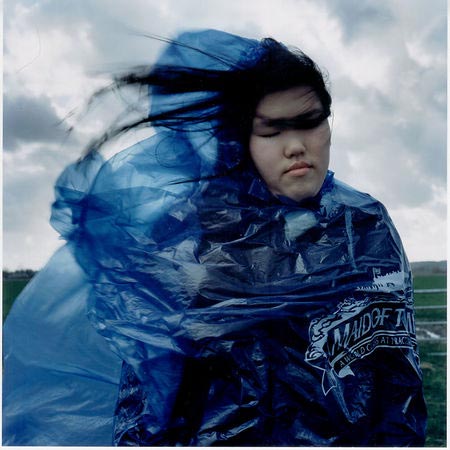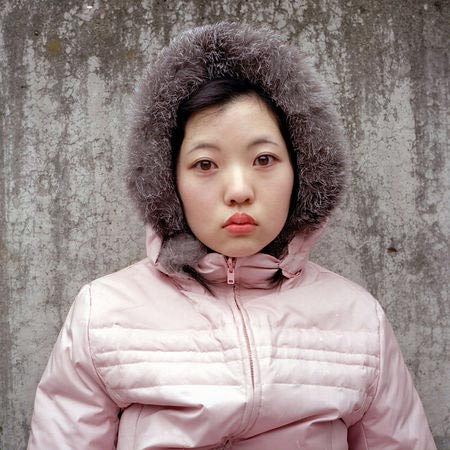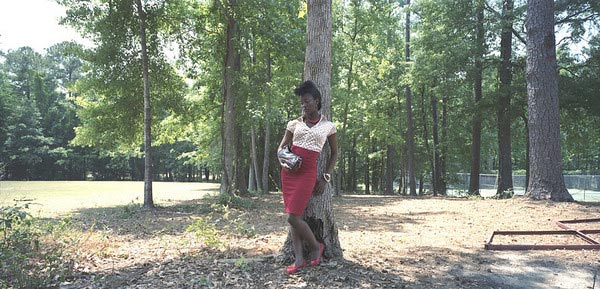A Conversation with Hellen Van Meene

Portraiture might be the most challenging photographic endeavor. It is a complex interaction between the photographer’s intent, the subject’s preconceptions and ideas, and the viewer’s background. So how do photographers manage to make great portraits? I have long been a fan of Dutch photographer Hellen van Meene. Her portraits of adolescents possess an extremely quiet and forceful beauty. I’ve often wondered how she manages to create work that is so beautiful, while always avoiding the trap of producing mere clichés. Deciding to approach Hellen to talk to her about her images, I was particularly happy to not only get a glimpse of her ideas about her work, but to also to see some of her very new photos that have not yet been seen publicly.
Jörg Colberg: A portrait comes into being via the interaction between the photographer and the subject. During a discussion over dinner the other night, a photographer friend told my wife that it’s always the photographer who makes things happen, whereas my wife said that in the end, it all depended on what the subject was willing to give and ultimately on the subject’s underlying personality. I am wondering, from your experience of having done many portraits, who mostly determines the outcome of such a session? To what extent do you guide your subjects? And if you guide them do you guide them towards something specific that you’d like to see or towards something that you think might be there?
Hellen van Meene: I guide my subjects a lot. I always ask models that have no experience as models. They’re just girls and boys from the street. Because of that I always guide them, because I think a good photographer should know what they want from a subject. Once you have a model posing in front of you it is good to help them, by telling them in what direction to look or what pose to choose. That way, you can help them to have confidence, and to also feel relaxed with you.
If I was an insecure photographer, who didn’t know what to do at the moment when the photos are being taken, or if I was still thinking of some idea, it would be important not to show that. It’s important that the model feels that they can trust me because, they have to feel comfortable with me. They have to trust me that I am able to make a good photo of them.
Sometimes, the model can do something that I haven’t thought of before, and then of course I react. Suppose the model is changing her arms or legs in a composition so that I think “Wow! That is very interesting. Please hold that!” And then I take another photo. So it is always the interaction between the model and me. But it’s most important that I am always in control or, at least, I always believe that I am.

JC: Are there photographers who have served as inspiration for your work?
HvM: I don’t really have a very good example of a photographer that inspired me. There are photographers that I think are really great. I like Sally Mann’s work that I recently saw a documentary of. It was a very good to see how she is working and what she is like as a person. I really was fascinated by it. Of course, there also is Diane Arbus.
But I never really looked at other photographers closely and then made a photo that relied on them. I never really look at many photography books actually. I’m a bit lazy in that sense. My husband is much more keen on buying photo books and seeing what everyone is doing. Usually, I’m more interested in concentrating on my own work. I do admire some photographers, but it’s not that I feel like “this photographer inspired what I’m doing at the moment”.
JC: You work a lot with adolescents. What is your motivation for this? Is taking portraits of adolescents different from taking portraits of adults?
HvM: When you work with young people, you notice they’re open and so flexible. It’s so different from working with adults or with elderly people. A young person is so open and so fresh, you can guide them much more than adults.
If you’re taking portraits of someone in their forties, you find they really know what they want, so it’s more difficult to pry them open, to get into their soul, to really get a feel of the person. It’s more difficult because they already know what they want from life, they already have experienced things, either positive or negative; and that results in a different outcome.
I still feel more related to younger people, even though I am 35 years old now. I guess you could say I’m approaching my forties, but I still feel closer to young people. I like them, I like how for them everything is still open: whatever they can become in life. It’s very interesting; it always inspires me so much. They are the generation that I feel responsible for, to guide them and to take good photographs, so that they will not be insecure about themselves. I can help them being proud of the photo we have taken together - and that means that when they are older, they will be able to say “Wow! Look how I was when I was so young!”

Taking photos of young people gives me more space for my photographs. You cannot dress a forty-year old in different kind of clothes, because then it looks like you’re setting something up; and it looks like fake. If you put a younger woman into different kinds of clothes - which is sometimes very important in my photos, not like in fashion photography, but it’s a detail that makes the photos - that gives the photos a much more interesting space, and it add more details. But if you would put a fifty-year old into a simple top or negligé then you get a different atmosphere than when you do it with young people. In that case, the clothes are important, but it looks like they are less significant. With a fifty-year old in a top you can easily see that the skin is older and that everything has changed, and that’s not what I’m looking for.
I don’t know if I’m explaining this well, but I think that young people are so inspiring, and I love to be inspired by them. They’re so open and new and fresh, they have to explore everything, and I love to guide that. Maybe when I’m much older, say in my sixties, I will think about forty-year old models, but not right now.
I also work only with daylight, because I think it is most important to give my model all the attention they need. When I work outside in natural light I can interact straight away when I see that the light is much better on the tree next to me. So I can ask the model to step aside. In a studio I would feel too limited. There, the light has already been set up, and if you would want to change it you are less focused on the model and more on the light equipment in the studio. I like to be more focused on the model, and daylight is so beautiful!

JC: I often get asked “Tell me what makes a good portrait” - as if it was possible to simply tell. Is it possible? What makes a good portrait for you? When you edit your work, how do you pick the work to show?
HvM: When you take photos it always feels like butterflies in your stomach when you have a good photo. When the light is perfect and the model is looking great, you feel it right away, like being struck by lightening; you know “Wow, this is good, this must be a good photo.”
When the films are developed and I have the negatives, I always scan the film to see if the photo is as good as I remember it, and in 90% of the cases it is what I expected to be, a very good photograph. So it’s a lot about getting this sparkle inside of you, when you know “Wow, this is good!”
It might happen that you don’t have the sparkle and then later think “Hey, maybe I wasn’t paying so much attention, this is a good image.” That can happen, but usually you already know if it’s a good photo or not when you take it.
And what makes a good photo? I think it’s about a combination of things, this kind of chemistry of the model looking great, the light being perfect, she’s having her hands on the perfect place on the dress - all these details make it happen.
I do remember when I was in art school my drawing teacher said “A drawing is really good when it also looks good upside down.” I have to admit that I never turn my photos upside down, so I don’t have a trick to tell what makes a good photo. I think it’s more like I have this special twinkle inside me, and I know it’s a good photo. You don’t have it with every photo. If you are really honest and you look very closely at the photos then you know which ones have this special twinkle. I just had one this weekend, and I knew “Oh boy, this is a good one”. Even talking about it has me very excited…
How do you know you’re in love with someone, even if s/he is not your type? You also know it. And what is? Is it his eyes, is it this or that… I think it’s the chemistry, and that is with same with photography, you feel there is chemistry.

JC: I think last year I saw a show with your work in New York, and one of the things I noticed was the print size. In a day and age where many photographer prefer huge prints yours were fairly small, which - I thought - only enhanced their power because you had to step a bit closer to interact with them. How do you determine what size to print? Isn’t bigger better?
HvM: My print size - that’s a good question. I always had really small photos. My smallest photos are 29 by 29cm [11 by 11”], and my larger photos are 39 by 39cm [15 by 15”]. What I really love of these sizes is that when you look at a photo in an exhibition, you have to stand in front of it, and your head is about as big as the photo you’re looking at. It also means that when you’re looking at the photo only you can look at it at that moment. Another person has to wait until you are done with it.
When you are standing in front of a very large photo, you have a different kind of feeling and relationship with the photo. It is so large that you always share that moment with other people next to you. So there’s a different kind of relationship with the photo.
I think it’s better for some photos to have this kind of intimacy, when you have to look at it getting closer. You can then see more details. It is a bit strange, but I always think that when a photo is really large you can probably see everything much better. When I look at a very large photo I always think I’ve seen everything. But because it’s so large I maybe don’t invest the time the photo needs. With a small photo, I always spend more time with it, because I don’t want to miss anything. The small photo demands more attention, it demands for you to look more closely so you don’t miss a thing.
It’s also important to realize that photos don’t get better when they’re bigger, so there’s no reason why I should print them larger.

I have to admit, though, that I’m now working with a new camera, a panoramic camera. My usual negatives are 6x6cm - a square. Now, I sometimes I work with the Rolleiflex, and sometimes with the panoramic camera, whose negative size is 6x12cm, so the negative is twice the size. It’s 6cm longer, so you get a wide-screen effect. When enlarging them they are 40 by 80cm. It’s still not really big, but for me, it’s rather big, because it’s 80cm now, 40cm longer than my former standard size
It is very fascinating, because now you can see more of the portrayed than before, and you see some of the atmosphere and the surroundings. So that is a new step I’m working on, and I really like that. But I think I will always stick to the sizes 40x40cm and 40x80cm, not bigger. They don’t get better when printed bigger, so why should you do it then?
This conversation was commissioned by American Photo and can also be found here. The images are courtesy Yancey Richardson, New York City, and Sadie Coles HQ, London
 By
By